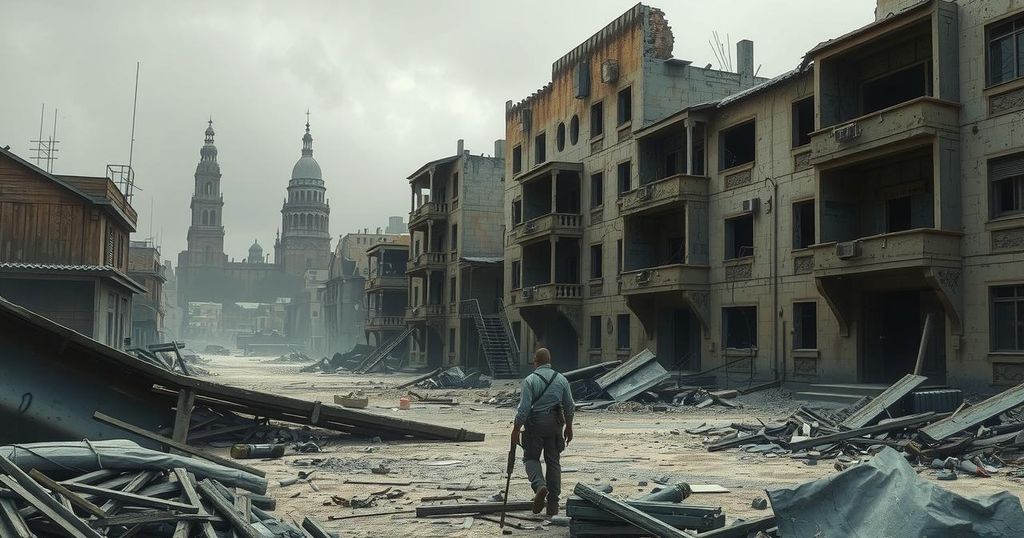Scars of War Persist in Goma, Eastern DR Congo Amid Ongoing Conflict
Goma, once a bustling city in the DRC, has been taken over by M23 rebels, leading to a breakdown in daily life and a humanitarian crisis. Over 1.2 million people are displaced as violence persists, despite attempts at ceasefires. Key infrastructure is in ruins, and hospitals are overwhelmed with casualties.
In the eastern Democratic Republic of the Congo (DRC), Goma once thrived as a busy border town beneath the imposing Mount Nyiragongo. However, following the seizure of the city by the March 23 Movement (M23) rebel group, tranquility has become a fragile and uneasy facade. It has been more than three months since M23 took control on January 27, marking a troubling resurgence of conflict in a region long familiar with strife.
The takeover this year by M23 echoes a similar incident from 2012 when the group temporarily captured Goma. The violence has turned daily life upside down. Residents face heavy shelling and ongoing military confrontations, with significant casualties reported. According to government figures, over 8,500 people have lost their lives, with close to 5,600 injured amidst fierce fighting that has engulfed neighborhoods and key infrastructures like airports and radio stations.
Despite M23’s declaration of a “humanitarian ceasefire” on February 4, hostilities have not ceased. Fighting in North and South Kivu provinces continues undeterred, with rebels securing territories such as Bukavu, the capital of South Kivu. Analysts suggest that this phase may be even more entrenched than previous conflicts, especially with M23’s goals extending beyond Goma, as hinted by Corneille Nangaa, the political leader of M23, who expressed ambition to liberate all of DRC, including its capital, Kinshasa.
Post-takeover, Goma is marked by a heavy silence, the sounds of gunfire replaced by a pervasive sense of disorder. Economic activity has ground to a halt; commercial districts are eerily quiet while the banking system has nearly collapsed, leading to chronic cash shortages that paralyze transactions. As a result, crime rates have surged, particularly at night, and residents find themselves subject to the new authority of M23, which has set up checkpoints and imposed taxes.
The humanitarian crisis provoked by these upheavals is staggering. The International Organization for Migration reports that over 1.2 million individuals have been displaced in the Kivu provinces since the beginning of the year. Those who fled to Goma for safety now find themselves uprooted again, many returning to devastated homes or communities rendered uninhabitable.
In a particularly urgent move, the M23 issued an ultimatum in early February, which led to the rapid evacuation of major displacement camps, like Bulengo and Lushagala. Families departed hastily, carrying whatever they could. Sadly, many returning home discovered their lands completely ravaged, with scenery unrecognizable due to destruction and inaccessible roads.
Sake, a town roughly 27 kilometers west of Goma, has seen fierce fighting and is now considered Goma’s last line of defense. After prolonged combat since late 2023, the streets are in ruins, leaving residents like Christian Kabuya alarmed by the presence of unexploded ordnance in their surroundings. “We’ve found live shells in over ten locations,” he shared. Tragically, there have been reported fatalities, including among children, from accidental detonations.
At Ndosho Hospital in western Goma, the only facility still treating casualties, medical staff are facing relentless pressure. Supported by the International Committee of the Red Cross (ICRC), it operates under extreme strain amidst rising casualties. “The situation here is uniquely complex,” remarked Taoffic Mohamed Toure, an ICRC veteran, shedding light on the difficulties of working in eastern DRC filled with varied conflicting entities and incessant violence.
As diplomatic initiatives stall and ceasefire agreements falter, Goma’s citizens grapple with the grim remnants of war. The lava flows from Nyiragongo may have solidified, but the scars of conflict indelibly mar the landscape of Goma, and peace remains a distant hope for its people.
The current situation in Goma and the eastern DRC remains precarious following the M23 rebel control. As fighting continues, many face displacement and hardships, while humanitarian efforts struggle to keep pace with escalating needs. The outlook for peace seems bleak, with residents bearing the heavy scars of ongoing conflict, indicating a long road ahead for the region.
Original Source: english.news.cn




Post Comment